This is a small flake fracture that is treated like a sprain
Healing:
It normally takes 6 weeks for this fracture to heal.
Smoking will slow down your healing. We would advise that you stop smoking while your fracture heals. Talk to your GP or go to www.smokefree.nhs.uk for more information.
Pain and swelling:
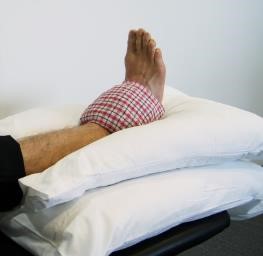
You may have foot pain and swelling for 3-6 months after your injury. Swelling is often worse at the end of the day.
Taking pain medication, elevating your foot and using ice or cold packs will help. More information is in the next section.
Walking and your boot:
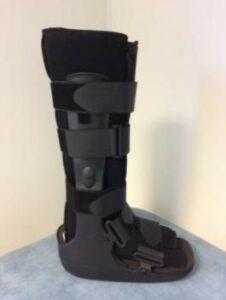
The boot protects your foot and will make you more comfortable. Wear the boot when you are standing and walking. You can take it off at night and at rest. You need to wear the boot for 2 weeks after your injury. Please inform us if you are diabetic; you may require a specialist boot.
You are allowed to put weight through your foot. You may find it easier to use crutches in the early stages.
Exercises:
It is important to start exercises as soon as possible. Instructions are in the next section.
Follow up:
A follow up appointment is not normally needed for this injury. If you still have significant pain and swelling after 3 months, then please contact the Virtual Fracture Clinic team.
Any questions:
If you are concerned about your symptoms, are unable to follow this rehabilitation plan or have pain other than at the site of your injury please contact the Virtual Fracture Clinic team.
Caring for your injury: Week 1-2
Remember to wear your boot whenever standing and walking. You can remove the boot when resting, at night and to wash and dress. Wear a long sock in your boot.
Using a cold pack will help with your pain and swelling. You can use an ice pack or bag of frozen peas wrapped in a damp towel. Put this on your foot for up to 15 minutes every few hours. Make sure the ice is not in direct contact with your skin.
Try to rest your foot, especially in the first 24-72 hours. Raise your foot on a stool or cushions to that it is above the level of your hip. This will help to reduce your swelling.
Exercises:
Early movement of the ankle and foot is important to promote circulation and reduce the risk of developing a Deep Vein Thrombosis (blood clot). If you notice any swelling or redness in the calf, please attend A&E.
Do these exercises 3-4 times a day. Start straight away, you do not need to push into pain.
1. Point your foot up and down. Repeat this 10 times.
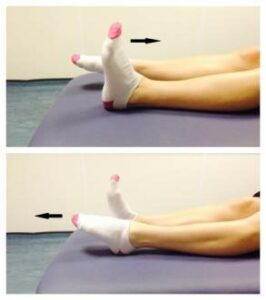
2. With your heels together, move your toes apart to turn the foot outwards. Repeat this 10 times. Do this movement gently within comfort.
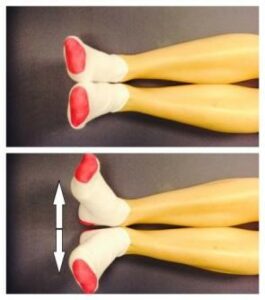
3. Make gentle circles with your foot in one direction and then the other direction. Repeat this 10 times.
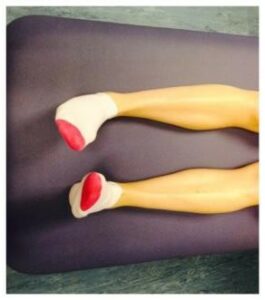
Caring for your injury: Week 2-6
It is now 2 weeks since your injury and you can start to wean out of your boot. Stop using it around your own home first and continue wearing it for longer distances. You should aim to be walking without your boot by 6 weeks after injury.
It is normal to still have mild discomfort and swelling. This may continue for 3-6 months.
Activity and Exercise
Keep doing your exercises until you recover full movement of your foot.
Gradually increase your level of activity. You should avoid impact activity for 3 months. This includes running and jumping.
Frequently Asked Questions
I am struggling with my boot. What do I do?
The boot has a thicker sole; this can make you feel uneven. Make sure you wear a supportive shoe or trainer on your uninjured foot. This will reduce stress on other joints. If you are struggling to wean out of your boot please contact us.
If you need more advice contact the Virtual Fracture Clinic.
I am diabetic, does this change things?
If you are diabetic please contact us to discuss your boot. This is particularly important if you have problems with your skin. We may provide you with a specialist diabetic boot.
When can I start driving?
You can return to driving when:
- You are no longer using your boot
- You can walk comfortably
- You can perform an emergency stop pain free
Always test your ability to drive in a safe environment first.
How can I get a certificate for work?
You can self-certify for the first 7 days following your injury. For any longer periods, please discuss the provision of a fitness to work statement with the Virtual Fracture Clinic Team or your GP.
What do I do with my boot and crutches when I no longer need them?
We are not able to use boots again. These should not be returned to the hospital.
Crutches can be returned to the Fracture Clinic or A&E.
Contact Details for Bedford and Luton
Please contact the hospital where you attended A&E as the other site will not be able to access your notes
BEDFORD HOSPITAL PATIENTS
How do I contact the Virtual Fracture Clinic (VFC)
- Telephone 01234 792036
- Messages will be checked every morning Monday to Friday (except for Bank Holidays)
- Email VFCBedford@bedfordhospital.nhs.uk
How do I contact the Fracture Clinic?
- Telephone 01234 792138
How do I contact the Plaster Room?
- Telephone 01234 792031
- Monday to Friday 9am to 5pm (out of hours contact the Emergency Department)
LUTON & DUNSTABLE HOSPITAL PATIENTS
How do I contact the Virtual Fracture Clinic (VFC)
- Telephone 01582 718121
- Messages will be checked every morning Monday to Friday (except for Bank Holidays)
- Email VFCLuton@ldh.nhs.uk
How do I contact the Fracture Clinic?
- Telephone 01582 497194 or 01582 718 993 (outpatient appointments)
How do I contact the Plaster Room?
- Telephone 01582 491166 (ext. 2233)
- Monday to Friday 9am to 5pm (out of hours contact the Emergency Department)
